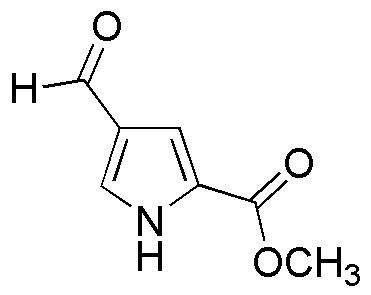Methyl 4-formyl-1H-pyrrole-2-carboxylate is widely utilized in research focused on:
- Synthesis of Pharmaceutical Compounds: This chemical serves as an important intermediate in the synthesis of various pharmaceuticals, particularly in the development of anti-inflammatory and anti-cancer drugs, enhancing therapeutic options for patients.
- Organic Electronics: It is used in the fabrication of organic semiconductors, which are crucial for the development of flexible electronic devices, such as organic light-emitting diodes (OLEDs) and organic photovoltaic cells, promoting advancements in sustainable energy solutions.
- Material Science: The compound is employed in creating novel polymer materials with enhanced properties, such as improved thermal stability and mechanical strength, which are beneficial in various industrial applications.
- Biological Research: Researchers utilize this chemical in the study of biological systems, particularly in the exploration of enzyme activity and metabolic pathways, providing insights into cellular processes and potential therapeutic targets.
- Flavor and Fragrance Industry: It is also used in the formulation of flavoring agents and fragrances, contributing to the development of new products in the food and cosmetic industries, enhancing consumer experiences.
General Information
Properties
Safety and Regulations
Applications
Methyl 4-formyl-1H-pyrrole-2-carboxylate is widely utilized in research focused on:
- Synthesis of Pharmaceutical Compounds: This chemical serves as an important intermediate in the synthesis of various pharmaceuticals, particularly in the development of anti-inflammatory and anti-cancer drugs, enhancing therapeutic options for patients.
- Organic Electronics: It is used in the fabrication of organic semiconductors, which are crucial for the development of flexible electronic devices, such as organic light-emitting diodes (OLEDs) and organic photovoltaic cells, promoting advancements in sustainable energy solutions.
- Material Science: The compound is employed in creating novel polymer materials with enhanced properties, such as improved thermal stability and mechanical strength, which are beneficial in various industrial applications.
- Biological Research: Researchers utilize this chemical in the study of biological systems, particularly in the exploration of enzyme activity and metabolic pathways, providing insights into cellular processes and potential therapeutic targets.
- Flavor and Fragrance Industry: It is also used in the formulation of flavoring agents and fragrances, contributing to the development of new products in the food and cosmetic industries, enhancing consumer experiences.
Documents
Safety Data Sheets (SDS)
The SDS provides comprehensive safety information on handling, storage, and disposal of the product.
Product Specification (PS)
The PS provides a comprehensive breakdown of the product’s properties, including chemical composition, physical state, purity, and storage requirements. It also details acceptable quality ranges and the product's intended applications.
Certificates of Analysis (COA)
Search for Certificates of Analysis (COA) by entering the products Lot Number. Lot and Batch Numbers can be found on a product’s label following the words ‘Lot’ or ‘Batch’.
*Catalog Number
*Lot Number
Certificates Of Origin (COO)
This COO confirms the country where the product was manufactured, and also details the materials and components used in it and whether it is derived from natural, synthetic, or other specific sources. This certificate may be required for customs, trade, and regulatory compliance.
*Catalog Number
*Lot Number
Safety Data Sheets (SDS)
The SDS provides comprehensive safety information on handling, storage, and disposal of the product.
DownloadProduct Specification (PS)
The PS provides a comprehensive breakdown of the product’s properties, including chemical composition, physical state, purity, and storage requirements. It also details acceptable quality ranges and the product's intended applications.
DownloadCertificates of Analysis (COA)
Search for Certificates of Analysis (COA) by entering the products Lot Number. Lot and Batch Numbers can be found on a product’s label following the words ‘Lot’ or ‘Batch’.
*Catalog Number
*Lot Number
Certificates Of Origin (COO)
This COO confirms the country where the product was manufactured, and also details the materials and components used in it and whether it is derived from natural, synthetic, or other specific sources. This certificate may be required for customs, trade, and regulatory compliance.


